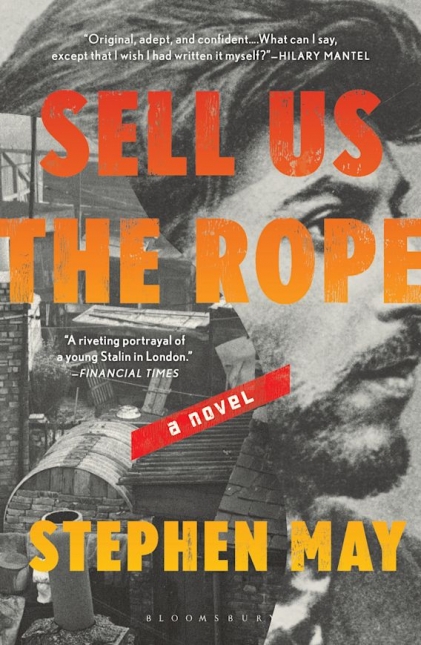Sell Us the Rope: A Novel
- By Stephen May
- Bloomsbury Publishing
- 240 pp.
- Reviewed by Tom Glenn
- March 21, 2023
Though heavy on facts, this work is light on fiction.

Sell Us the Rope is a novel about an historical event — the 5th Congress of the Russian Communist Party in May 1907 in London. Nearly all the characters in the story are based on real people, starting with the protagonist, Joseph Stalin. We meet him on the first page as he descends a gangplank at the port of Harwich with two associates, Stepan Shaumian and Mikhail Tskhakaya.
“They attract the eye, these men,” writes author Stephen May. “Koba — you know him as Stalin — is small and wiry, his face pock-marked, dark hair dishevelled, eyes burning from beneath a perpetual frown…Koba is the most energetic of the three even when not moving. His leg twitches, pulsing to some internal music.”
As the story proceeds, many more historical figures appear. Among them are Vladimir Lenin, Leon Trotsky, Maxim Gorky, Julius Marton (the leading Menshevik), and a host of others. Non-Russian characters are equally authentic. These include the Polish German Rosa Luxemburg, the American millionaire and philanthropist Joseph Fels, and the Finnish lathe worker Elli Vuokko.
We soon learn that Stalin, a native of Georgia, is the son of a humble shoemaker. He is indeed a member of the working class, which he hopes to rescue and elevate through his revolution. And he is short — only five feet, five inches tall.
The book’s third-person-omniscient (aka “God’s eye”) point of view means we’re privy to the inner thoughts of all the characters; we know what’s going on in everybody’s head. There’s one exception, though: In the sections dealing with Stalin, the viewpoint is restricted to his alone. We don’t learn what those around him are thinking. It’s an unusual approach, but it works.
Among the other oddities that show up as the story progresses is the strong preference for wearing tiaras among the women in the group, especially the older ones. I couldn’t figure out why since the tiara is a symbolic crown, the very thing the Soviet movement ostensibly opposed.
As becomes more apparent as the tale unfolds, there is considerable disagreement between the two main factions represented at the Congress, the Bolsheviks and the Mensheviks. The former — including Stalin and Lenin — are more radical and elitist, while the latter support more progressive change in collaboration with the middle class and the bourgeoisie. (After the Russian Revolution, the Mensheviks were suppressed; many fled Russia to survive.)
Getting through the book was not easy for this American reader. Author May, a Brit, occasionally uses expressions, spellings, and constructions I wasn’t familiar with, and his avoidance of commas and use of single quotes to delineate speech tripped me up several times. Nor is there a conventional plot. Almost no time is devoted to what happens at the Congress. The reader learns instead of the interactions between Stalin and others, and about the doings of the female characters, especially Elli and her companions. There is no sense of conflict resolution or character development. At the end, everything is pretty much as it was at the beginning.
We learn the origin of May’s title near the conclusion of the story, when Lenin’s major rival, Alexander Bogdanov, cites the old saying that “when it comes time to hang the capitalists, they will sell us the rope.” This suggests to me, at least, that the underlying theme here is meant to involve relations between the Bolsheviks and the capitalists, but it never materializes.
Throughout, many characters express fear of Okhrana, the secret police of Tsarist Russia, known for its cruelty and use of torture. Yet Stalin’s own savagery is on display, too, such as when he kills a 15-year-old boy named Gotsridze. First, Stalin has his companions knock the boy unconscious, then he shoots Gotsridze between the eyes and proceeds to saw through the corpse’s chest and cut out the heart, all to send a message to anyone else thinking of crossing him. As for Stalin himself — who will go on to slaughter an estimated 20 million of his own people — the bloody episode means little:
“Surely, taking a life — cutting out a young heart — surely meant that you were forever altered? But it turned out that it was like losing your virginity. Changed nothing. It left no scars, no marks at all. Not at first. Not until the dead started gawping at you in parks. And you could get used to that easily enough. You can get used to anything.”
The author deserves credit for his detailed description of the Communist hierarchy as it prepared for the revolution that would topple Tsar Nicholas II in 1918. But Sell Us the Rope is presented as a work of historical fiction, suggesting we’re in for an imagined look at how the protagonist — even one based on such a familiar real-life figure as Stalin — copes with obstacles and moves through life. Instead, what we get is an able account of the long-ago 5th Congress of the Russian Communist Party in London. What we don’t get is a novel.
Between 1962 and 1975, Tom Glenn, Ph.D., comfortable in seven languages, spent more time in Vietnam than he did in the U.S. His work was signals intelligence on the battlefield targeting the North Vietnamese. Now a fulltime author, he has six books, 17 short stories, and several nonfiction articles in print.

